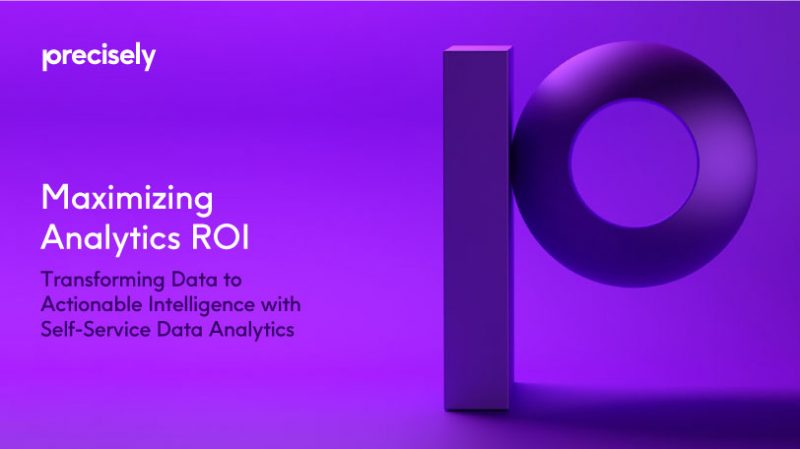eBook
Maximizing Analytics ROI
Transforming Data to Actionable Intelligence with Self-Service Data Analytics.
Do You Speak Data Prep?
Some time ago, we asked the question, “Do you speak data governance?” because everyone needed governance, but no one seemed to have the same definition for it. And now we’re talking about the evolution of data preparation. Here, the quandary isn’t whether everyone understands data preparation, it’s who’s doing it, how quickly, and how well. The term “data preparation” has evolved as fast as the tools for the task, and those who continue to use outdated analytics tools that rely on technical resources will fall further and further behind the competition. And organizations who aren’t making their data work for them will cease to exist.
Data preparation is the process of gathering, combining, cleansing, structuring and organizing data so it can be analyzed as part of data visualization, analytics and machine learning applications. Sound complicated? Traditionally, it was, with technical tools that required coding expertise and other specialized skills that could only be performed by a select few. These were typically data scientists, working within the confines of IT departments. Enterprise access to data and analysis went through them. They fielded all requests, preparing and analyzing data and providing results to users. While not a perfect solution, it worked. Requests came in, reports and results went out.

The Evolution of BI and Analytics
Spreadsheet applications remained the analysis tool of the masses, with some spreadsheet wranglers doing amazing things, and others making, with all of them limited by a lack of flexibility, scalability and repeatability. Meanwhile, BI tools proliferated, further teasing business users with the possibilities of detailed data reporting and visualization. With so much potential, requests proliferated, and backlogs soon followed. IT was understandably overwhelmed with user requests, taking weeks and often months to fulfill them.
To appease irritated users, IT departments in some organizations liberated data and opened access to company datasets to allow “self-service” data use. Predictably, this generated a new tsunami of siloed data, reports with contradictory information and widespread mistrust of data’s source and accuracy.
As these issues proliferated, business leadership teams across the world began to see the success data- driven organizations could derive as big companies like Amazon, Facebook and Google leveraged data analytics for profitability, innovation and growth. Organizations had long used data analysis for myriad one-off business operations and strategic purposes, but now it seemed everyone wanted to capitalize on the analytic possibilities.
The Democratization of Data Demands Different Tools
The fact is, the democratization of data is well underway. As business users are increasingly empowered with the knowledge to use data, they are demanding a stake in how data is managed and deployed. Because the traditional tools of data preparation are notoriously slow, there’s a desperate need for advanced, powerful and flexible tools that handle big data of all types. That’s why self-service data analytics is the next great thing.
Historically, data preparation has been a time-consuming, inefficient process for a wide range of reasons. IT bottlenecks and extensive manual processes have meant data preparation takes, and wastes, a tremendous amount of time. Data pros struggle to find and access data, integration is labored, and cleansing can be torturous.
The tools are part of the problem as well. Traditional tools for data preparation are great at so many things, but are now being asked to do things their developers never envisioned. Spreadsheet applications generate frequent errors and are unreliable and unscalable tools in data preparation. Traditional ETL solutions are cumbersome, requiring schema-based data flows and “waterfall” development cycles. Traditional relational database models can have costly overhead and be highly rigid.
Two Birds, One Self-Service Data Solution
Agile data preparation, on the other hand, solves many of the biggest issues with these legacy data preparation tools and allows more people to engage in data analysis through a self-service model. It delivers speed with flexible data handling, virtually eliminating pre-planning and data modeling time. When deployment time is critical, it can deliver flexibility and take the place of traditional ETL tools, and also provide rapid prototyping of data flows before integrating them into traditional ETL environments.
To empower business users, the self-service interface allows them to address new questions as they arise, eliminating the need to involve development staff to add to expenses and slow down the process. A flexible solution offers a library of interfaces and adapters to give users rapid access to data from any data source, and a single, visual workflow interface enables on-the-fly improvements to data quality and adjustments to business logic. Users can easily manipulate data, blending data from different sources to create custom analytics that yield highly accurate results.
This combination of simplicity and self-service means organizations can quickly amplify their data analytics efforts to yield better decision-making and improved outcomes.

Do You Speak Data Prep?
Some time ago, we asked the question, “Do you speak data governance?” because everyone needed governance, but no one seemed to have the same definition for it. Fast forward to 2019, and now we’re talking about the evolution of data preparation. Here, the quandary isn’t whether everyone understands data preparation, it’s who’s doing it, how quickly, and how well. The term “data preparation” has evolved as fast as the tools for the task, and those who continue to use outdated analytics tools that rely on technical resources will fall further and further behind the competition. And organizations who aren’t making their data work for them will cease to exist.
Data preparation is the process of gathering, combining, cleansing, structuring and organizing data so it can be analyzed as part of data visualization, analytics and machine learning applications. Sound complicated? Traditionally, it was, with technical tools that required coding expertise and other specialized skills that could only be performed by a select few. These were typically data scientists, working within the confines of IT departments. Enterprise access to data and analysis went through them. They fielded all requests, preparing and analyzing data and providing results to users. While not a perfect solution, it worked. Requests came in, reports and results went out.
The Evolution of BI and Analytics
Spreadsheet applications remained the analysis tool of the masses, with some spreadsheet wranglers doing amazing things, and others making, with all of them limited by a lack of flexibility, scalability and repeatability. Meanwhile, BI tools proliferated, further teasing business users with the possibilities of detailed data reporting and visualization. With so much potential, requests proliferated, and backlogs soon followed. IT was understandably overwhelmed with user requests, taking weeks and often months to fulfill them.
To appease irritated users, IT departments in some organizations liberated data and opened access to company datasets to allow “self-service” data use. Predictably, this generated a new tsunami of siloed data, reports with contradictory information and widespread mistrust of data’s source and accuracy.
As these issues proliferated, business leadership teams across the world began to see the success data- driven organizations could derive as big companies like Amazon, Facebook and Google leveraged data analytics for profitability, innovation and growth. Organizations had long used data analysis for myriad one-off business operations and strategic purposes, but now it seemed everyone wanted to capitalize on the analytic possibilities.
The Democratization of Data Demands Different Tools
The fact is, the democratization of data is well underway. As business users are increasingly empowered with the knowledge to use data, they are demanding a stake in how data is managed and deployed. Because the traditional tools of data preparation are notoriously slow, there’s a desperate need for advanced, powerful and flexible tools that handle big data of all types. That’s why self-service data analytics is the next great thing.
Historically, data preparation has been a time-consuming, inefficient process for a wide range of reasons. IT bottlenecks and extensive manual processes have meant data preparation takes, and wastes, a tremendous amount of time. Data pros struggle to find and access data, integration is labored, and cleansing can be torturous.
The tools are part of the problem as well. Traditional tools for data preparation are great at so many things, but are now being asked to do things their developers never envisioned. Spreadsheet applications generate frequent errors and are unreliable and unscalable tools in data preparation. Traditional ETL solutions are cumbersome, requiring schema-based data flows and “waterfall” development cycles. Traditional relational database models can have costly overhead and be highly rigid.
Two Birds, One Self-Service Data Solution
Agile data preparation, on the other hand, solves many of the biggest issues with these legacy data preparation tools and allows more people to engage in data analysis through a self-service model. It delivers speed with flexible data handling, virtually eliminating pre-planning and data modeling time. When deployment time is critical, it can deliver flexibility and take the place of traditional ETL tools, and also provide rapid prototyping of data flows before integrating them into traditional ETL environments.
To empower business users, the self-service interface allows them to address new questions as they arise, eliminating the need to involve development staff to add to expenses and slow down the process. A flexible solution offers a library of interfaces and adapters to give users rapid access to data from any data source, and a single, visual workflow interface enables on-the-fly improvements to data quality and adjustments to business logic. Users can easily manipulate data, blending data from different sources to create custom analytics that yield highly accurate results.
This combination of simplicity and self-service means organizations can quickly amplify their data analytics efforts to yield better decision-making and improved outcomes.

Improve and Expand Your Analytical Capabilities
The truism, “You learn something new every day” is a common phrase we’ve all heard since childhood. The fact is the constant pursuit of knowledge can pay dividends both personally and professionally. By educating yourself daily, you are likely to gain new insights, expand your horizons and widen your perspective. Because another well-known axiom is also true: Knowledge is power.
This axiom is equally applicable in business. Organizations that consistently expand their knowledge, broaden their understanding and increase their analytical insights are stockpiling valuable intelligence and the fuel for innovation and competitive differentiation. It is simple. Knowledge is power and the more power you have, the more likely you are to succeed.
In business, learning something new about your customers, organizational processes and operational efficiencies is a major business advantage. Business users across a range of industries work overtime to use their data to uncover market trends and opportunistic business information. However, there are a variety of barriers that prevent even the best organizations from conducting timely analysis to turn data into critical insights.
One key issue businesses face is the management of their enterprise data supply chain. It is often a challenge for organizations to quickly turn raw data into actionable and reliable information. Reliance on traditional extract, transform and load (ETL) tools compounds this problem. Unfortunately, legacy ETL tools are outdated, overly technical and cumbersome. They drain money, time and resources, and leave business users largely dependent on IT experts for any data analysis. Enterprises need modern tools that foster business/IT collaboration and empower business users to become more involved in data analysis for better strategic analytical insights.
The Move Away from Traditional ETL Tools
Business users don’t often have the expertise needed to use ETL tools for data analysis. They must submit these requests to their IT resources, who typically are overworked and overwhelmed with an abundance of similar requests. The request goes to the back of the queue, creating a backlog of tasks. By the time IT addresses the request, the data is outdated and irrelevant for their business purpose.
Transitioning towards modern self-service data and analytics technologies enables enterprises to provide business users greater transparency and flexibility to enable advanced analytics without creating an IT bottleneck. With a comprehensive data intelligence platform, organizations can eliminate time- consuming, manual data prep procedures. They can deliver data to business users in real time – without waiting for limited IT expertise.
With a comprehensive, integrated data intelligence platform, enterprises deliver business users a self- service data experience that combines data governance, data analytics and data quality to meet their data needs for better business insights. The long wait times of traditional data prep are eliminated, as users can access any data source easily, and simply acquire and parse that data in a fraction of the time. In addition, business users can visually collaborate as they extract, prepare and analyze data from unrelated sources, and create a comprehensive source for analysis.
With transparency into every step of the process, and with the automation of data blending and cleansing to enable users to profile, aggregate, correlate and transform selected data, the power of advanced analytics is now at their fingertips. With a unified toolset for preparing data, creating models and embedding those predictive analytics within any business process, organizations can uncover analytical insights that were previously impossible to find.
Expanding Possibilities for Greater Analytical Insights
A great example of finding previously undiscoverable analytical insights comes from the telecom industry. A leading satellite radio company was using legacy tools to help track free trials, paid subscriptions and lapsed subscriptions. When a consumer bought a new car, they received a 30-day free satellite trial. These legacy tools reconciled those who signed up for a paid subscription and those who didn’t, but the process was labor-intensive and needed extensive manual intervention. This resulted in rampant issues with paid customers not receiving their service and unpaid customers continuing to receive services after the trial period expired.
By using an agile self-service data solution, the company quickly determined significant errors were costing them both money and opportunity. Their legacy tools were incapable of tracking subscriptions in real-time. Customer experience suffered, as paid users were understandably frustrated when they stopped receiving services, while others continued receiving services without charge. The opportunity for timely follow- up with trial participants was also squandered. By streamlining the program and timely data analysis, the company cut waste, saved time and money, and improved customer satisfaction.
Data analysis can have a major impact on an organization’s operational efficiency and overall growth. With a modern approach to data prep and analytics, enterprises can empower business users to gain impactful knowledge into the customer experience, operational effectiveness and enterprise-wide business processes to grow revenue and develop data-backed solutions. Combined with data quality and data governance for an integrated solution, companies can streamline their overall data management strategy and ensure maximum return on their data.
“Data analysis can have a major impact on an organization’s operational efficiency and overall growth.”

How to Expand Analytical Possibilities into a Competitive Advantage
Realizing the full potential of data and analytics is a challenge in many organizations. With so much data to leverage, businesses must adopt modern tools and technologies that enable all users to self-service their own data prep and analytics needs.
Data analytics help fast-paced businesses increase operational efficiencies, drive customer retention and growth, and optimize organizational processes. The most successful businesses capitalize on data analytics’ ability to uncover market trends, map out the competitive landscape and evaluate performance to set themselves apart from the competition. Insight-driven businesses are also using data analytics to better understand internal operations, measure brand reputation and predict customer behavior.
Despite the many advancements enabled by analytics across multiple industries, even some of the most sophisticated organizations don’t realize the full value of their data. They run into obstacles turning data into insights with inefficient data processes, poor data quality and absence of business alignment. Unfortunately, these are not the only data challenges businesses face. Too often over-reliance on IT, overly technical tools and outdated technologies often prevents organizations from using data to drive greater business impact.
Breaking Down Analytical Obstacles
One fundamental issue organizations face is how they should maintain and manage their enterprise data supply chain. When data is collected, shared and deployed at today’s rapid pace, it is often a challenge for organizations to swiftly convert data into actionable and trustworthy insights.
With so much data at stake, the IT department is often the only organizational resource equipped with the tools and ability to manage, prepare and analyze large-scale data volumes. However, business users are the primary consumers of enterprise data. All too often, these users are left confused and confounded by the technical languages IT uses such as SQL, Java, Python and more.
Compounding these data issues further is widespread reliance on conventional extract, transform and load (ETL) technologies for data integration and analysis. While these tools serve a purpose and facilitate data movement in critical processes, we can’t ignore the need to show collaboration between business and IT to enable business users to get involved in strategic data analysis, which isn’t always easy with established data integration tools.
Transitioning Toward Business Enablement
Most individuals typically lack the knowledge needed to leverage ETL and other highly technical tools for data analysis. Instead, they must submit data requests to their IT department, who are already busy with myriad data requests from other business users. As a result, it takes weeks to fulfill requests as IT works to address the backlog of work already in the queue. By the time each request is fulfilled, the results may well be outdated or irrelevant to the requester.
By moving toward more modern technologies that enable self-service data analytics options, organizations provide greater transparency and flexibility, and enable more users to perform data analysis without continued reliance on limited IT resources. Building a common understanding of usable data for the individual consumer is the greatest challenge. By implementing a governance-first approach to data management enables more collaboration and facilitation of data exchanges.
The latest data management technologies also offer the advantage of integrated capabilities, offering organizations all-inclusive options that bring data governance, data quality and data analytics together to give business users high quality data that they can trust. Now that trust is well-established, diverging lines of business can easily collaborate as they extract, prepare and analyze data from a variety of data sources, producing an all-inclusive and dependable source for analysis that all business users can use. And there’s an added benefit of cutting the lengthy wait times that most end users expect today.
By selecting a tool that provides complete lineage of every data supply chain, combined with extensive capabilities to automate data blending and cleansing, users can search, find, create and manage insights—all while ensuring the trust is proven. This allows organizations to substantially expand analytical possibilities, put the power of data at the fingertips of any user, and put an end to IT bottlenecks that throttle speed to insights. Because in today’s competitive business landscape, delayed results can be costly.






